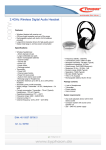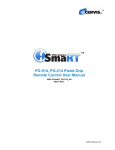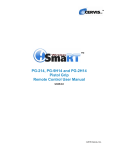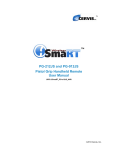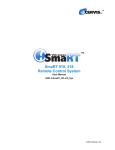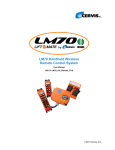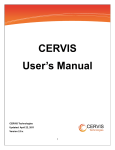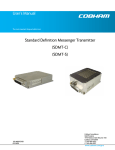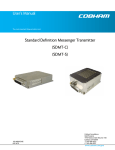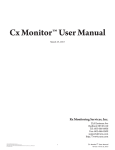Download SmaRT 918XF and 218XF Base Unit
Transcript
™ ™ SmaRT BU-x18XF and BU-xH18XF Base Units User Manual U069.2.0-SmaRT_BU-x18XF 2015 Cervis, Inc. SmaRT BU-x18XF and BU-xH18XF This document is the property of Cervis, Inc. and cannot be copied, modified, e-mailed, or reproduced without the express prior written consent of Cervis, Inc. Cervis, Inc. reserves the right to change this manual or edit, delete, or modify any information without prior notification. FCC Statements 15.19 – Two Part Warning This device complies with Part 15 of the FCC rules. Operation is subject to the following two conditions: (1) This device may not cause harmful interference and (2) This device must accept any interference received, including interference that may cause undesired operation. 15.21 – Unauthorized Modification NOTICE: The manufacturer is not responsible for any unauthorized modifications to this equipment made by the user. Such modifications could void the user’s authority to operate the equipment. 15.105(b) – Note: This equipment has been tested and found to comply with the limits for a Class B digital device, pursuant to Part 15 of the FCC Rules. These limits are designed to provide reasonable protection against harmful interference in a residential installation. This equipment generates, uses and can radiate radio frequency energy and, if not installed and used in accordance with the instructions, may cause harmful interference to radio communications. However, there is no guarantee that interference will not occur in a particular installation. If this equipment does cause harmful interference to radio or television reception, which can be determined by turning the equipment off and on, the user is encouraged to try to correct the interference by one or more of the following measures: Reorient or relocate the receiving antenna. Increase the separation between the equipment and receiver. Connect the equipment into an outlet on a circuit different from that to which the receiver is connected. Industry Canada Statement This device complies with Canadian RSS-210. The installer of this radio equipment must ensure that the antenna is located or pointed such that it does not emit RF field in excess of Health Canada limits for the general population; consult Safety Code 6, obtainable from Health Canada’s website www.hc-sc.gc-ca/rpb. Le présent appareil est conforme aux CNR d'Industrie Canada applicables aux appareils radio exempts de licence. L'exploitation est autorisée aux deux conditions suivantes : (1) l'appareil ne doit pas produire de brouillage, et (2) l'utilisateur de l'appareil doit accepter tout brouillage radioélectrique subi, même si le brouillage est susceptible d'en compromettre le fonctionnement. Industry Canada Statement This device complies with Industry Canada licence-exempt RSS standard(s). Operation is subject to the following two conditions: (1) this device may not cause interference, and (2) this device must accept any interference, including interference that may cause undesired operation of the device. Le présent appareil est conforme aux CNR d'Industrie Canada applicables aux appareils radio exempts de licence. L'exploitation est autorisée aux deux conditions suivantes : (1) l'appareil ne doit pas produire de brouillage, et (2) l'utilisateur de l'appareil doit accepter tout brouillage radioélectrique subi, même si le brouillage est susceptible d'en compromettre le fonctionnement. IC Unlicensed Devices EIRP Statements for Removable Antennas Part 1: Under Industry Canada regulations, this radio transmitter may only operate using an antenna of a type and maximum (or lesser) gain approved for the transmitter by Industry Canada. To reduce potential radio interference to other users, the antenna type and its gain should be so chosen that the equivalent isotropically radiated power (e.i.r.p.) is not more than that necessary for successful communication. Conformément à la réglementation d'Industrie Canada, le présent émetteur radio peut fonctionner avec une antenne d'un type et d'un gain maximal (ou inférieur) approuvé pour l'émetteur par Industrie Canada. Dans le but de réduire les risques de brouillage radioélectrique à l'intention des autres utilisateurs, il faut choisir le type d'antenne et son gain de sorte que la puissance isotrope rayonnée équivalente (p.i.r.e.) ne dépasse pas l'intensité nécessaire à l'établissement d'une communication satisfaisante. Part 2: This radio transmitter (LOBSRF-305) has been approved by Industry Canada to operate with the antenna type listed below with the maximum permissible gain and required antenna impedance for each antenna type indicated. Antenna types not included in this list, having a gain greater than the maximum gain indicated for that type, are strictly prohibited for use with this device. Le présent émetteur radio (LOBSRF-305) a été approuvé par Industrie Canada pour fonctionner avec les types d'antenne énumérés ci-dessous et ayant un gain admissible maximal et l'impédance requise pour chaque type d'antenne. Les types d'antenne non inclus dans cette liste, ou dont le gain est supérieur au gain maximal indiqué, sont strictement interdits pour l'exploitation de l'émetteur. RoHS Compliance Statement Cervis, Inc. complies with the requirements of Restriction of Hazardous Substances (RoHS/WEEE) Specification based on in-house practice and declaration of compliance from our vendors. For additional information concerning RoHS compliance, please contact Cervis, Inc. at: CERVIS, Inc. 170 Thorn Hill Road Warrendale, PA 15086 Phone: 724.741.9000 Fax: 724.741.9001 This product may contain material that may be hazardous to human health and the environment. In compliance with EU Directive 2002/96/EC on Waste Electrical and Electronic Equipment (WEEE): Do not dispose of the product as unsorted municipal waste. This product should be recycled in accordance with local regulations. Contact local authorities for detailed information. This product may be returnable to the distributor for recycling. Contact your distributor for details. Cervis, Inc. Visit our Web site at: www.cervisinc.com 2015 Cervis, Inc. All rights reserved. Content is subject to change without notice. Base Unit Manual Table of Contents List of Figures ............................................................................................................................. iii List of Table ................................................................................................................................. iii Note to the Manual User ............................................................................................................. iv Related Documents ..................................................................................................................... iv Cautions and Notes .................................................................................................................... iv 1.0 Safety Instructions ............................................................................................................... 1 1.1 What You MUST Do .......................................................................................................... 1 1.2 What You MUST NOT Do.................................................................................................. 1 2.0 BU-x18XF Base Unit............................................................................................................. 2 3.0 SmaRT BU-x18XF Options .................................................................................................. 3 3.1 BU-x18XF/BU-xH18XF Base Unit Installation ................................................................ 4 3.2 BU-x18XF Base Unit Wiring Diagram and Connectors Pinout ..................................... 5 4.0 SmaRT BU-x18XF in SmaRT Remote Control Systems ................................................... 6 5.0 Associate Mode .................................................................................................................... 7 6.0 BU-x18XF and BU-xH18XF Specifications ........................................................................ 8 7.0 LED Diagnostic Troubleshooting ....................................................................................... 9 Appendix A: Exposure to Radio Frequency Energy .............................................................. 10 Appendix B: Agency Identification Label Locations .............................................................. 10 Appendix C: BU-218XF Declaration of Conformity ................................................................ 11 List of Figures Figure 1. SmaRT BU-x18XF/BU-xH18XF Base Unit .................................................................... 2 Figure 2. BU-xH18XF Base Unit Mounting Dimensions ............................................................. 4 Figure 3. BU-x18XF/BU-xH18XF Field Wiring .............................................................................. 5 Figure 4. SmaRT BU-x18XF/BU-xH18XF with SmaRT Remote Control Unit Examples .......... 6 Figure 5. Handheld to BU-x18XF/BU-xH18XF Associate Example ............................................ 7 Figure 6. Agency Identification Label Locations ...................................................................... 10 List of Table Table 1. SmaRT BU-x18XF and BU-xH18XF Options ................................................................. 3 Table 2. BU-x18XF/BU-xH18XF P1 and P2 Connectors Pinout ................................................. 5 Table 3. SmaRT BU-x18XF and BU-xH18XF Specifications....................................................... 8 Table 4. SmaRT BU-x18XF LED Troubleshooting Hints ............................................................ 9 2015 Cervis, Inc. iii SmaRT BU-x18XF and BU-xH18XF Note to the Manual User Note: The standard SmaRT base unit is available to operate at 900MHz or 2.4GHz using Direct Sequence Spread Spectrum (DSSS) wireless technology. To avoid repetition and possible confusion, the base unit may be referred to as the BU-x18XF or BU-xH18XF throughout this document where x represents either 900MHz as 9—for BU-918XF or BU-9H18XF, or 2.4GHz as 2—for BU-218XF or BU-2H18XF. Related Documents System related Cervis, Inc. Engineered System Approval document Appropriate SmaRT remote control user manual Contact us with questions during installation or troubleshooting at (724) 741-9000. Cautions and Notes Cautions warn the user that certain circumstances or conditions warrant that the user be aware of a presence of danger that may result in harm, or even death, to personnel or destruction of equipment. Please see the following example: Prevent inadvertent movement of the machine while establishing the communication link between SmaRT base units and remote controls. Always remove power from the base unit before attempting to enter Associate. Notes, such as the following example, provide information that may be useful to the user or are pertinent to the operation of the system. Note: Cervis provided harness wires are either color coded or individually numbered to aid in properly wiring the controlled devices to the P1 and P2 base unit connectors. iv U069.2.0-SmaRT_BU-x18XF Base Unit Manual 1.0 Safety Instructions These instructions must be read carefully in order to install and use the system properly, to keep it in safe working condition, and to reduce the risks of misuse. Do not use this system in potentially explosive atmospheres. Any use other than that specified in this manual is DANGEROUS. Strict adherence to the following instructions is a MUST. Note: To comply with FCC RF exposure compliance requirements, this device and its antenna must not be co-located or operating in conjunction with any other antenna or transmitter. Certain adjustments may need to be made while the controlled machinery is active. All personnel must be at a safe distance from the machine during these adjustments to avoid risk of injury or accidental death. 1.1 What You MUST Do Strictly adhere to the installation instructions contained in this manual. Keep the transmitter out of reach of unauthorized personnel. Make sure that professional and competent personnel carry out the installation. Make sure that all site and prevailing safety regulations are fully followed. Make sure that this manual is permanently available to the operator and maintenance personnel. At the beginning of each work day, check to make sure that the Stop Button and other safety measures are working. When in doubt, press the Stop Button. An audible or visual warning device indicating the machine is electrically active and that the transmitter has control should be installed on the machine. Service the equipment periodically. Whenever several systems have been installed, make sure the transmitter you are about to use is the right one. Identify the machine controlled by the transmitter on the transmitter label (customer supplied). When carrying out repairs, only use parts supplied by Cervis dealers. 1.2 What You MUST NOT Do Never make changes to the system that have not been studied and approved by Cervis. Never use the system when visibility is limited. Never power the equipment with anything other than with the specified power supply. Never allow unqualified personnel to operate the equipment. Never leave the equipment ON after use. Always use or the Stop Button to avoid accidental movements. Never abuse the transmitter. Avoid dropping. Never use the system if failure is detected. SmaRT BU-x18XF and BU-xH18XF 2.0 BU-x18XF Base Unit Figure 1. SmaRT BU-x18XF/BU-xH18XF Base Unit The versatile BU-x18XF and BU-xH18XF base units—where x=2 for 2.4GHz, or 9 for 900MHz operation—feature eighteen FET (field effect transistor) high-side switching outputs or switch-toground digital inputs, factory configurable dual 0-10VDC or 0-20mA analog inputs that can also be configured as digital outputs/inputs, and CAN Bus control capability. Eight pairs of base unit FET channels can be equipped with high-side current sense for better control of valve coil pairs. Table 1 on page 3 lists available configurations and options. The BU-x18XF and BU-xH18XF accept a broad range of input power with operating voltages ranging from 7VDC to 28VDC. The rugged weatherproof translucent enclosure allows these units to operate worry free in harsh weather conditions. Color-keyed or wire-numbered weatherproof cable harnesses connect the controlled devices. These base units provides a robust communication link with up to eight SmaRT remotes in congested radio environments using Direct Sequence Spread Spectrum (DSSS) wireless technology at 900MHz or 2.4GHz. Base units and remotes feature seamless association without the need to open the enclosures. There is a variety of available SmaRT remote control units to choose from, multiple examples of which are shown in Figure 4. Features Eighteen solid-state FET outputs/inputs Two 0–10V or 4–20mA inputs, or digital input/outputs (factory configurable) 900MHz or 2.4GHz Direct Sequence Spread Spectrum technology Dual uniquely keyed connectors for ease of wiring Diagnostic LEDs +7 to +28VDC power Compact design Rugged, weatherproof construction Communicates with up to eight SmaRT remotes Optional RS-232 models for SmaRT Connect use (see Table 1, Figure 3, or Table 2) 2 U069.2.0-SmaRT_BU-x18XF Base Unit Manual 3.0 SmaRT BU-x18XF Options Table 1. SmaRT BU-x18XF and BU-xH18XF Options Common 18 Channel Features: FETs; 7-28VDC Input Power Serial Port Display SmaRT Connect NA CAN No No NA CAN No No External NA CAN Yes No Internal NA CAN Yes No 2mW External (2) 4-20mA IN CAN Yes No 2.4GHz 2mW Internal (2) 4-20mA IN CAN Yes No BU-218XF-EXT-AI2 2.4GHz 2mW External (2) 4-20mA IN CAN No No BU-218XF-INT-AI2 2.4GHz 2mW Internal (2) 4-20mA IN CAN No No BU-218XF-EXT-DIS-AV2 2.4GHz 2mW External (2) 0-10V IN CAN Yes No BU-218XF-INT-DIS-AV2 2.4GHz 2mW Internal (2) 0-10V IN CAN Yes No BU-218XF-EXT-AV2 2.4GHz 2mW External (2) 0-10V IN CAN No No BU-218XF-INT-AV2 2.4GHz 2mW Internal (2) 0-10V IN CAN No No BU-2H18XF-EXT-CAN 2.4GHz 100mW External NA CAN No No BU-2H18XF-INT-CAN 2.4GHz 100mW Internal NA CAN No No BU-2H18XF-EXT-DIS-CAN 2.4GHz 100mW External NA CAN Yes No BU-2H18XF-INT-DIS-CAN 2.4GHz 100mW Internal NA CAN Yes No BU-2H18XF-EXT-DIS-AI2-CAN 2.4GHz 100mW External (2) 4-20mA IN CAN Yes No BU-2H18XF-INT-DIS-AI2-CAN 2.4GHz 100mW Internal (2) 4-20mA IN CAN Yes No BU-2H18XF-EXT-AI2-CAN 2.4GHz 100mW External (2) 4-20mA IN CAN No No BU-2H18XF-INT-AI2-CAN 2.4GHz 100mW Internal (2) 4-20mA IN CAN No No BU-2H18XF-EXT-DIS-AV2-CAN 2.4GHz 100mW External (2) 0-10V IN CAN Yes No BU-2H18XF-INT-DIS-AV2-CAN 2.4GHz 100mW Internal (2) 0-10V IN CAN Yes No BU-2H18XF-EXT-AV2-CAN 2.4GHz 100mW External (2) 0-10V IN CAN No No BU-2H18XF-INT-AV2-CAN 2.4GHz 100mW Internal (2) 0-10V IN CAN No No BU-2H18XF-EXT-SC* 2.4GHz 100mW External NA RS-232 No Yes BU-2H18XF-INT-SC* 2.4GHz 100mW Internal NA RS-232 No Yes BU-9H18XF-EXT 900MHz 10mW External NA CAN No No BU-9H18XF-INT 900MHz 10mW Internal NA CAN No No BU-9H18XF-EXT-DIS 900MHz 10mW External NA CAN Yes No BU-9H18XF-INT-DIS 900MHz 10mW Internal NA CAN Yes No BU-9H18XF-EXT-DIS-AI2 900MHz 10mW External (2) 4-20mA IN CAN Yes No BU-9H18XF-INT-DIS-AI2 900MHz 10mW Internal (2) 4-20mA IN CAN Yes No BU-9H18XF-EXT-AI2 900MHz 10mW External (2) 4-20mA IN CAN No No BU-9H18XF-INT-AI2 900MHz 10mW Internal (2) 4-20mA IN CAN No No BU-9H18XF-EXT-DIS-AV2 900MHz 10mW External (2) 0-10V IN CAN Yes No BU-9H18XF-INT-DIS-AV2 900MHz 10mW Internal (2) 0-10V IN CAN Yes No BU-9H18XF-EXT-AV2 900MHz 10mW External (2) 0-10V IN CAN No No BU-9H18XF-INT-AV2 900MHz 10mW Internal (2) 0-10V IN CAN No No BU-9H18XF-EXT-SC* 900MHz 10mW External NA RS-232 No Yes BU-9H18XF-INT-SC* 900MHz 10mW Internal NA RS-232 No Yes Model Freq. RF Antenna Analog Chan. BU-218XF-EXT BU-218XF-INT 2.4GHz 2mW External 2.4GHz 2mW Internal BU-218XF-EXT-DIS 2.4GHz 2mW BU-218XF-INT-DIS 2.4GHz 2mW BU-218XF-EXT-DIS-AI2 2.4GHz BU-218XF-INT-DIS-AI2 *Device does not have CAN interface available. SC connectivity using the RS-232 port allows the user to directly configure the BU-x18XF and BU-xH18XF using SmaRT Connect. 2015 Cervis, Inc. 3 SmaRT BU-x18XF and BU-xH18XF 3.1 BU-x18XF/BU-xH18XF Base Unit Installation Make sure the machine to which the base unit is to be installed is disabled during installation. 74.9mm (2.95”) 133mm (5.25”) Use the configuration diagrams supplied by Cervis as a guide when mounting the base unit and connecting the wiring harnesses. Dimensions for drilling mounting holes are shown in are shown in Figure 2. Wiring diagram and connector pinout is shown in Figure 3. 102mm (4”) centers 7.4mm (0.29”) dia. BU-x18XF BU-xH18XF 36mm (1.4”) 118mm (4.7”) Figure 2. BU-xH18XF Base Unit Mounting Dimensions 4 U069.2.0-SmaRT_BU-x18XF Base Unit Manual 3.2 BU-x18XF Base Unit Wiring Diagram and Connectors Pinout Figure 3. BU-x18XF/BU-xH18XF Field Wiring Table 2. BU-x18XF/BU-xH18XF P1 and P2 Connectors Pinout P1 Pin Assigned P1 Pin Assigned P2 Pin P1:1 +VDC P1:7 M13 P2:1 M5 P2:7 +VDC P1:2 M17 P1:8 M14 P2:2 M6 P2:8 CANL or RS-232 RX P1:3 M9 P1:9 M15 P2:3 M7 P2:9 M1 P1:4 M10 P1:10 M16 P2:4 M8 P2:10 M2 P1:5 M11 P1:11 M18 P2:5 CANH or RS-232 TX P2:11 M3 P1:6 M12 P1:12 VDC P2:6 Umbilical PWR P2:12 M4 2015 Cervis, Inc. Assigned P2 Pin Assigned 5 SmaRT BU-x18XF and BU-xH18XF 4.0 SmaRT BU-x18XF in SmaRT Remote Control Systems The basic standard SmaRT Remote Control System consists of at least one SmaRT base unit, a SmaRT remote control unit, and the wiring harness that is used to connect the base unit to the controlled apparatus. A single base unit is capable of communicating with multiple SmaRT remotes—up to eight—a variety of which are available including the PTO-xH06, the PG-xH14 pistol-grip, the OO-218, and MCB-xH4JS handheld remotes, and the SmaRT Console Remote examples as shown in Figure 4. Communications between the base unit and the remotes are established at the factory using the Associate process, which can also be easily performed on site when necessary using the SmaRT remote. Associate processes for each remote control unit are described in detail in each SmaRT remote manual and Cervis Engineering SpecSheet. PG-xH14-DIS Pistol Grip Remote PG-xH12JS Pistol Grip Remote HH-xH06 Handheld Remote HH-218-DIS Remote HH-xH10 Handheld Remote MCB-xH4JS Remote BU-x18XF/BU-xH18XF Base Unit CB-xH4LV Remote PG-xH14 Pistol Grip Remote Figure 4. SmaRT BU-x18XF/BU-xH18XF with SmaRT Remote Control Unit Examples 6 U069.2.0-SmaRT_BU-x18XF Base Unit Manual 5.0 Associate Mode Communication between the SmaRT BU-x18XF and SmaRT remotes is established while the system is at the factory before it is shipped. The process can be applied in the field when necessary—when a remote is replaced or added for example. Access to and the exact button or switch sequencing used while in Associate mode will vary depending on the type of SmaRT remote with which the base unit is to communicate. Please reference the appropriate SmaRT remote control manual or Cervis Engineering SpecSheet for complete Associate Mode details. Prevent inadvertent movement of the machine while establishing the communication link between SmaRT base units and remote controls. Always remove power from the base unit before attempting to enter Associate. Associate Example The following example shows the steps taken to associate as standard SmaRT PTO-x06 six button handheld remote to a SmaRT BU-x18XF base unit. 1. Remove power from the base unit and turn OFF the hand-held device. 2. Stand near the base unit in unobstructed, clear line-of-sight with the handheld in hand. 3. Simultaneously press and hold the Associate (B1) and Dissociate (B2) buttons. RX and ER light. 4. Continue to hold both buttons until TX and RX light steady. 5. When TX and RX light, release B1 and B2. ER and BA light. Note: If the next button press is not immediately performed (approximately 2sec.), all LEDs flash and the Associate procedure is aborted. The process must be started anew to establish the communication link. 6. Immediately press and hold the Associate button (B1). All LEDs light. 7. TX begins to slowly blink. Continue to hold B1. 8. Apply power to the base unit. The handheld and base unit begin to establish a communication link while the Associate button is held. Once the process is complete, all LEDs light briefly and then go out. 9. Release the Associate button. TX and RX will be flashing indicating the handheld is sending and receiving messages. The SmaRT System is ready for use. Associate (B1) Dissociate (B2) Figure 5. Handheld to BU-x18XF/BU-xH18XF Associate Example 2015 Cervis, Inc. 7 SmaRT BU-x18XF and BU-xH18XF 6.0 BU-x18XF and BU-xH18XF Specifications Table 3. SmaRT BU-x18XF and BU-xH18XF Specifications Item Description Power Vin +7 to +28VDC Radio Frequencies BU-218XF: 2405 – 2480MHz @ 2mW BU-2H18XF: 2405 – 2480MHz @ 100mW BU-9H18XF: 906 – 924MHz @ 10mW Environment License License Free Modulation DSSS Antenna Internal or External (RP-TNC) Operating Temp -20°C to 55°C (-4°F to 131°F) Storage Temp -40°C to 85°C (-40°F to 185°F) Humidity 0 to 100% Vibration/Shock IEC60068-2-6 10Hz to 150Hz @ 1.0g peak acceleration 10.0g peak shock acceleration LED Indicators (11 Red) Enclosure +V1, +V2, +V3 OK when lit 1 (HTH) Health (blinks when active) 2 (RTX) RF TX (blinks when active) 3 (RRX) RF RX (solid when active) 4 (CTX) CAN TX (blinks when active) 5 (CRX) CAN RX (blinks when active) 6 (OUT) Output (solid when active) 7 (IN) Input (solid when active) 8 (ERR) Error (solid when active) Dimensions mm: 133 x 118 x 36 (inch: 5.25 x 4.7 x 1.4) Durability High Impact Polymer Mounting Holes mm: 7.40 dia.; 102 center-to-center Inch: 0.29 dia.; 4.00 center-to-center Outputs/Inputs Eighteen FET—Open Drain Current 3A per channel 15A Max. total @ 50° C (122° F) Digital I/O (18) M1(Ch1) P2–9 M2 (Ch2) P2–10 M3 (Ch3) P2–11 M4 (Ch4) P2–12 M5 (Ch5) P2–1 M6 (Ch6) P2–2 M7 (Ch7) P2–3 M8 (Ch8) P2–4 M9 (Ch9) P1–3 M10 (Ch10) P1–4 M11 (Ch11) P1–5 M12 (Ch12) P1–6 M13 (Ch13) P1–7 M14 (Ch14) P1–8 M15 (Ch15) P1–9 M15 (Ch16) P1–10 M17 (Ch17) P1–2 M18 (Ch18) P1–11 0–10V or 4–20mA M17(Ch17) P1–2 M18 (Ch18) P1–11 Optional Umbilical Communications CAN Bus SAE J1939 SmaRT Connect SEE Table 1 Only units marked with –SC are RS-232 capable (CAN is not available) allowing SmaRT Connect use. Analog (2) (factory configurable) 8 Assignments U069.2.0-SmaRT_BU-x18XF Base Unit Manual 7.0 LED Diagnostic Troubleshooting Table 4. SmaRT BU-x18XF LED Troubleshooting Hints Indication Unmarked LED active Input power polarity is reversed +V1, +V2, +V3 Power LED not active Is +VDC input power present? Check input power polarity. RTX/RRX not active Check for obstructions preventing line-of-sight transmission. Check that the console box is active. Re-associate the console box to the base unit. Check CAN wiring. Check that the remote is active. Re-associate the remote to the base unit. Indicates an internal problem. Check that the handheld LEDs are active when the appropriate buttons are pushed. Check that startup sequence was followed. Check the outputs for loose wiring, etc. Over-temperature channel indication. Over-current channel indication. Active channel current consumption less than 1A typical. (This is not a problem in cases where less then 1A draw is a normal condition.) CTX/CRX not active Health LED blinking rapidly Out LED not active ERR LED active 2015 Cervis, Inc. 9 SmaRT BU-x18XF and BU-xH18XF Appendix A: Exposure to Radio Frequency Energy SmaRT handheld remote units contain radio transceivers. When active, handheld remotes send out radio frequency (RF) energy through its internal antenna. For optimal performance and to ensure that human exposure to RF energy does not exceed the recommended guidelines, always follow these instruction and precautions: When using the handheld remote, hold the remote so that the top buttons are away from the body in the direction of the base unit. Keep the remote when in use at least 15mm (5/8 inch) away from the body, and only use carrying cases, belt clips, or holders that are approved by Cervis, Inc. A SmaRT base unit when active sends out radio frequency (RF) through its external antenna. Base units using an external antenna should be mounted to ensure the antenna is at least 20cm away from the human body. Only the external antennas recommended by Cervis, Inc. are to be used. Appendix B: Agency Identification Label Locations Note: The base unit agency label position is Agency label will be here! identical for all base units including both internal antenna and external antenna, and 900MHz and 2.4GHz base units. Figure 6. Agency Identification Label Locations 10 U069.2.0-SmaRT_BU-x18XF Base Unit Manual Appendix C: BU-218XF Declaration of Conformity 2015 Cervis, Inc. 11 SmaRT BU-x18XF and BU-xH18XF Visit our Web site at www.cervisinc.com. Phone: (724) 741-9000 Fax: (724) 741-9001 2015 Cervis, Inc. All rights reserved. Content is subject to change without notice. Revised manuals are available for download at www.cervicinc.com. 12 U069.2.0-SmaRT_BU-x18XF
















